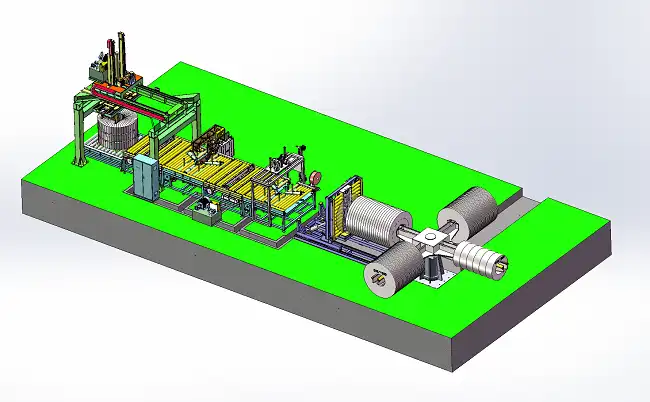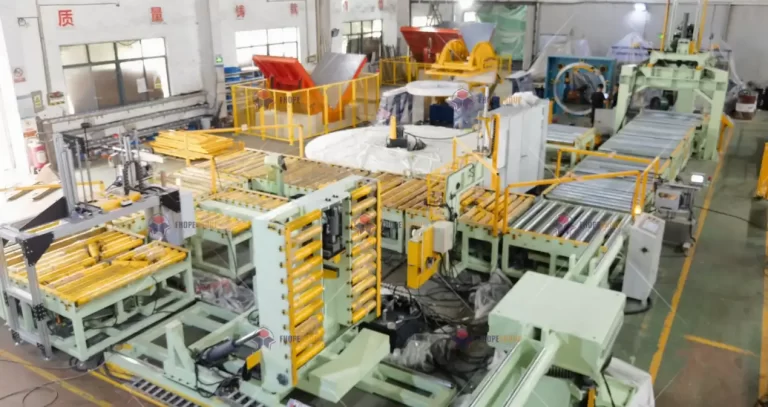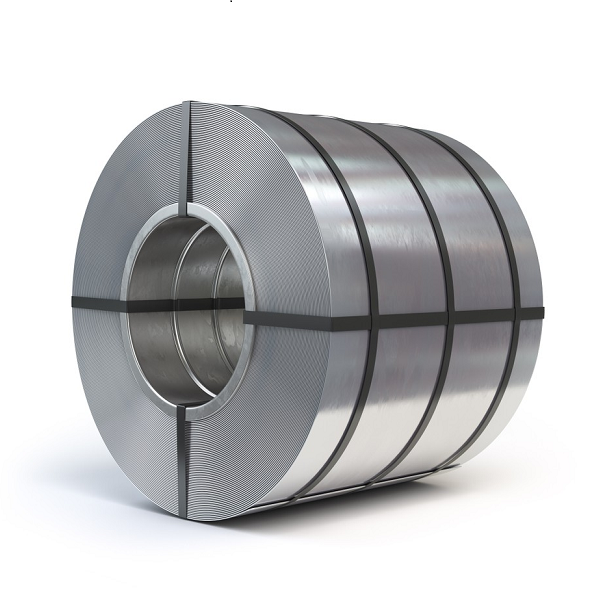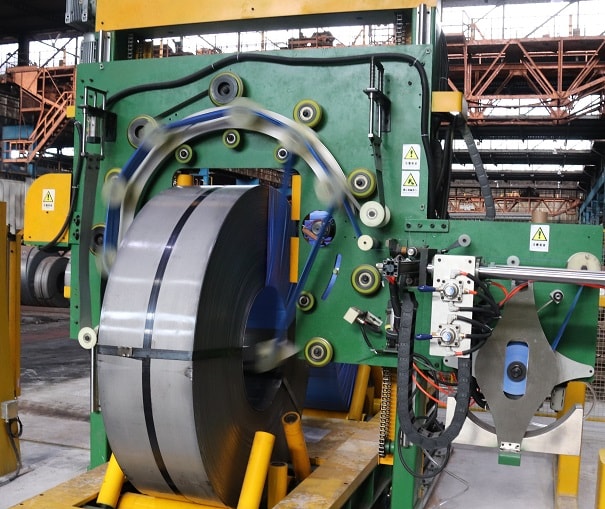In the world of metal processing, the efficient and secure packaging of coils is paramount to ensuring product quality, customer satisfaction, and overall operational success. Two primary solutions have emerged as the go-to options for businesses: coil packaging lines and coil packing systems. While both aim to streamline the process of preparing coils for transportation and storage, they possess distinct features that set them apart. In this comprehensive article, we'll dive deep into the key features of coil packaging lines and coil packing systems, examining their strengths, weaknesses, and suitability for various industrial applications.
By understanding the unique features and capabilities of these two solutions, decision-makers can make informed choices that align with their specific needs, goals, and constraints.
Heading 1: Throughput and Speed
One of the most critical aspects of any packaging solution is its ability to process coils efficiently and quickly. The throughput and speed of coil packaging lines and coil packing systems can vary significantly, impacting overall productivity and the ability to meet customer demand.
- Coil Packaging Lines: Designed for high-volume operations, coil packaging lines boast impressive throughput rates, often capable of processing up to 60 coils per hour or more, depending on the specific model and configuration. The seamless integration of automated processes, such as coil centering, wrapping, and strapping, enables these lines to maintain a consistent and swift pace, minimizing bottlenecks and maximizing output.
- Coil Packing Systems: While coil packing systems can also achieve respectable throughput rates, they may not match the speed and efficiency of fully automated packaging lines. The reliance on manual intervention and the potential for additional material handling between discrete stages can result in slower processing times and potential variations in output consistency.
Heading 2: Adaptability to Different Coil Sizes and Types
Metal processing businesses often deal with a wide range of coil sizes and types, making adaptability a crucial feature for any packaging solution. The ability to quickly and easily adjust to different coil dimensions and materials can significantly impact operational flexibility and the capacity to meet diverse customer requirements.
- Coil Packaging Lines: Many coil packaging lines offer a high degree of adaptability, featuring modular designs and quick changeover capabilities. Adjustable components, such as coil car bearings, centering devices, and wrapping arms, allow for swift transitions between different coil sizes and types, minimizing downtime and enabling a smooth, uninterrupted workflow.
- Coil Packing Systems: The adaptability of coil packing systems can vary greatly depending on the specific design and configuration. Some systems may offer a degree of flexibility through adjustable or interchangeable components, while others may be more limited in their ability to accommodate diverse coil sizes and types. This can potentially restrict the range of products a business can efficiently package and may require additional investment in specialized equipment for specific coil variations.
Heading 3: Packaging Material Compatibility
The selection and compatibility of packaging materials play a vital role in ensuring the protection, preservation, and marketability of coils during storage and transportation. Coil packaging lines and coil packing systems may differ in their ability to work with various packaging materials, affecting the level of customization and the quality of the final packaged product.
- Coil Packaging Lines: Advanced coil packaging lines often feature compatibility with a wide range of packaging materials, such as VCI paper, plastic film, corrugated sheets, and protective corner pads. The automated nature of these lines allows for precise and consistent application of packaging materials, ensuring a high level of protection and presentation. Some lines may even offer the flexibility to incorporate customized packaging elements, such as branded wrapping or specific labeling requirements.
- Coil Packing Systems: Coil packing systems may have more limited compatibility with packaging materials, depending on the specific equipment and processes involved. Manual wrapping and securing methods may not provide the same level of precision and consistency as automated systems, potentially affecting the quality and appearance of the packaged coils. Additionally, the ability to incorporate customized packaging elements may be more challenging or time-consuming in a manual packing environment.
Heading 4: Integration with Existing Infrastructure

The ease of integration with existing infrastructure, such as material handling equipment, storage systems, and IT networks, is a significant consideration when comparing coil packaging lines and coil packing systems. Seamless integration can minimize disruption, reduce implementation time, and optimize overall operational efficiency.
- Coil Packaging Lines: Many coil packaging lines are designed with integration in mind, offering compatibility with a wide range of upstream and downstream equipment. Standardized interfaces, modular designs, and advanced control systems facilitate smooth integration with existing material handling systems, such as coil cars, conveyors, and cranes. Additionally, the ability to connect with warehouse management systems (WMS) and other IT infrastructure enables real-time data collection, tracking, and analysis, facilitating informed decision-making and continuous improvement.
- Coil Packing Systems: The integration of coil packing systems with existing infrastructure may be more challenging, particularly if the system consists of disparate equipment and manual processes. The lack of standardization and automation can hinder seamless connectivity with material handling systems and IT networks, potentially leading to data silos and inefficiencies. However, some advanced coil packing systems may offer improved integration capabilities through modular designs and standardized interfaces, bridging the gap between manual and automated processes.
Heading 5: Maintenance and Upkeep
The ease of maintenance and upkeep is a critical factor in ensuring the long-term reliability, performance, and cost-effectiveness of any packaging solution. Coil packaging lines and coil packing systems may present different challenges and requirements when it comes to maintenance and servicing.
- Coil Packaging Lines: Automated coil packaging lines generally require a higher level of technical expertise for maintenance and troubleshooting. The complex integration of mechanical, electrical, and control systems necessitates skilled technicians and a well-planned preventive maintenance program. However, the modular nature of many packaging lines can simplify maintenance tasks, allowing for targeted interventions and minimizing overall downtime. Additionally, leading manufacturers often provide comprehensive aftersales support, including training, spare parts availability, and remote diagnostic services, ensuring optimal performance and quick resolution of any issues.
- Coil Packing Systems: The maintenance requirements for coil packing systems can vary depending on the level of automation and the complexity of the equipment involved. Manual packing systems may have lower maintenance demands, as they rely more on human intervention and less on sophisticated machinery. However, the lack of automation can lead to more frequent wear and tear on tools and equipment, requiring regular replacement and servicing. More advanced coil packing systems with automated components may necessitate a higher level of technical expertise for maintenance, similar to coil packaging lines. The key to effective maintenance in either case lies in regular inspections, timely repairs, and the availability of skilled personnel.
Heading 6: Safety and Ergonomics
The safety and ergonomics of a packaging solution are paramount, as they directly impact the well-being of operators and the overall productivity of the operation. Coil packaging lines and coil packing systems offer different levels of safety and ergonomic benefits, which should be carefully considered when making a selection.
- Coil Packaging Lines: Automated coil packaging lines inherently offer a higher level of safety and ergonomics compared to manual packing systems. By minimizing human intervention in the packaging process, these lines significantly reduce the risk of accidents, injuries, and strain-related disorders. Features such as automated coil handling, remote operation, and safety interlocks ensure that operators are kept out of harm's way while maintaining full control over the process. Moreover, ergonomic design principles, such as optimal working heights, reduced lifting requirements, and user-friendly interfaces, contribute to a more comfortable and efficient working environment.
- Coil Packing Systems: Manual coil packing systems may pose a higher risk of safety hazards and ergonomic challenges, as they rely heavily on human effort and interaction with the product. Operators are more exposed to potential injuries from heavy lifting, repetitive motions, and contact with sharp edges or rough surfaces. The lack of automation also increases the likelihood of human error, which can lead to accidents or product damage. However, the implementation of proper training, safety protocols, and ergonomic tools can mitigate these risks to a certain extent. More advanced coil packing systems that incorporate automated elements, such as assisted lifting devices or robotic arms, can significantly enhance safety and ergonomics, bridging the gap between manual and fully automated solutions.
Heading 7: Scalability and Future-Proofing
As businesses grow and evolve, the ability to scale and adapt packaging solutions to changing needs becomes increasingly important. Coil packaging lines and coil packing systems differ in their scalability and future-proofing potential, affecting long-term investment value and operational agility.
- Coil Packaging Lines: Coil packaging lines offer excellent scalability and future-proofing capabilities, thanks to their modular design and advanced automation features. As production volumes increase or product requirements change, these lines can be easily expanded, upgraded, or reconfigured to meet new demands. The addition of new modules, such as multiple wrapping stations or automatic labeling systems, can be seamlessly integrated into the existing line, boosting capacity and functionality without major disruptions. Furthermore, the inherent flexibility of automated lines allows for the introduction of new packaging materials, techniques, or industry standards, ensuring that the investment remains relevant and compliant in the long run.
- Coil Packing Systems: The scalability and future-proofing potential of coil packing systems largely depend on their level of automation and modularity. Manual packing systems may face limitations in terms of capacity expansion and adaptability to changing requirements. As production volumes grow, the reliance on human labor can become a bottleneck, and the introduction of new packaging methods or materials may require significant process changes and retraining. However, more advanced coil packing systems that incorporate modular designs and automated components offer better scalability and future-proofing options. These systems can be gradually upgraded or expanded to accommodate new demands, although the extent of scalability may still be limited compared to fully automated packaging lines.
Heading 8: Total Cost of Ownership
When evaluating coil packaging lines and coil packing systems, it's crucial to consider the total cost of ownership (TCO), which encompasses both initial investment and long-term operational costs. The TCO can vary significantly between the two solutions, influencing the overall financial viability and return on investment.
- Coil Packaging Lines: While coil packaging lines often require a higher initial investment compared to manual packing systems, they offer significant long-term cost benefits. The automated nature of these lines reduces labor costs, minimizes packaging material waste, and increases overall efficiency, leading to lower operational expenses. Additionally, the improved product protection and presentation achieved through automated packaging can result in fewer returns, claims, and customer complaints, further reducing associated costs. The modular and future-proof design of packaging lines also contributes to a lower TCO, as upgrades and expansions can be implemented cost-effectively over time.
- Coil Packing Systems: Manual coil packing systems typically have a lower initial investment cost, as they require less advanced equipment and automation. However, the long-term operational costs can be higher due to increased labor requirements, potential inefficiencies, and a higher risk of product damage or inconsistent packaging quality. As production volumes grow, the cost of manual labor can quickly escalate, eroding profit margins and limiting scalability. More advanced coil packing systems with automated components may offer a better balance between initial investment and long-term operational costs, but the TCO may still be higher than that of fully automated packaging lines when considering factors such as maintenance, upgrades, and adaptability to future needs.
Heading 9: Environmental Sustainability
In an era of increasing environmental awareness and stricter regulations, the sustainability of packaging solutions has become a key consideration for businesses. Coil packaging lines and coil packing systems can differ in their environmental impact, affecting a company's green credentials and compliance with sustainability standards.
- Coil Packaging Lines: Automated coil packaging lines offer several environmental benefits compared to manual packing systems. The precise and consistent application of packaging materials minimizes waste, reducing the overall consumption of resources. Advanced lines can also accommodate eco-friendly packaging materials, such as biodegradable films or recycled paper, further enhancing their environmental credentials. The energy efficiency of automated lines is another important factor, as optimized processes and modern equipment can reduce power consumption and associated carbon emissions. Moreover, the ability to integrate with IT systems allows for real-time monitoring and optimization of resource use, contributing to a more sustainable operation.
- Coil Packing Systems: The environmental impact of coil packing systems largely depends on the specific practices and materials employed. Manual packing processes may be more prone to packaging material waste due to inconsistencies in application and human error. The reliance on less eco-friendly materials, such as non-recyclable plastics or excessive protective layers, can also contribute to a higher environmental footprint. However, the adoption of sustainable practices, such as the use of recycled or biodegradable packaging materials and the implementation of waste reduction initiatives, can significantly improve the environmental performance of coil packing systems. More advanced systems with automated components may offer better control over material usage and waste generation, narrowing the gap with fully automated packaging lines in terms of sustainability.
Heading 10: Customer Perception and Brand Image
The choice between coil packaging lines and coil packing systems can have a significant impact on customer perception and brand image. In today's competitive market, the quality and presentation of packaged products play a crucial role in differentiating a business and building customer loyalty.
- Coil Packaging Lines: Automated coil packaging lines consistently produce high-quality, professionally packaged coils that enhance the perceived value and brand image of the product. The precise and uniform application of packaging materials, combined with the ability to incorporate custom branding elements, such as logos or product information, creates a premium look and feel that resonates with customers. The improved protection and presentation achieved through automated packaging also reduce the risk of damaged or unsightly products reaching the customer, preserving brand reputation and customer satisfaction. In an increasingly competitive market, the superior packaging quality delivered by coil packaging lines can be a key differentiator, helping businesses stand out and build a loyal customer base.
- Coil Packing Systems: The impact of coil packing systems on customer perception and brand image can vary depending on the quality and consistency of the manual packing process. Inconsistencies in packaging appearance, such as loose or unevenly applied wrapping, can detract from the overall product presentation and perceived value. The lack of automated precision may also result in a higher incidence of damaged or poorly protected coils reaching the customer, negatively affecting brand reputation and customer loyalty. However, well-trained operators and strict quality control measures can mitigate these risks to a certain extent, ensuring a more consistent and professional packaging outcome. The incorporation of custom branding elements may be more challenging in manual packing systems, limiting the opportunities for brand differentiation and premium positioning.
Conclusion
In conclusion, the choice between a coil packaging line and a coil packing system is a critical decision that requires careful consideration of various factors, including throughput and speed, adaptability to different coil sizes and types, packaging material compatibility, integration with existing infrastructure, maintenance and upkeep, safety and ergonomics, scalability and future-proofing, total cost of ownership, environmental sustainability, and customer perception and brand image.
Coil packaging lines offer significant advantages in terms of high-speed automation, consistent packaging quality, and the ability to handle a wide range of coil sizes and types. They provide a safer and more ergonomic working environment, excel in scalability and future-proofing, and contribute to a more sustainable operation. The superior packaging quality and presentation achieved through automated lines can also enhance customer perception and brand image, setting a business apart in a competitive market.
On the other hand, coil packing systems, particularly manual ones, may be more suitable for smaller-scale operations or businesses with limited budgets. They offer a lower initial investment cost and may require less advanced technical expertise for maintenance and operation. However, manual packing systems may face challenges in terms of throughput, consistency, safety, and adaptability to changing requirements.
Ultimately, the decision between a coil packaging line and a coil packing system should be based on a thorough assessment of a business's specific needs, goals, and constraints. By carefully weighing the features and benefits of each solution and aligning them with the company's strategic objectives, decision-makers can select the option that best positions their organization for long-term success in the competitive world of metal processing and packaging.





